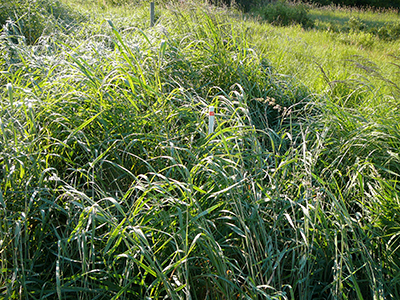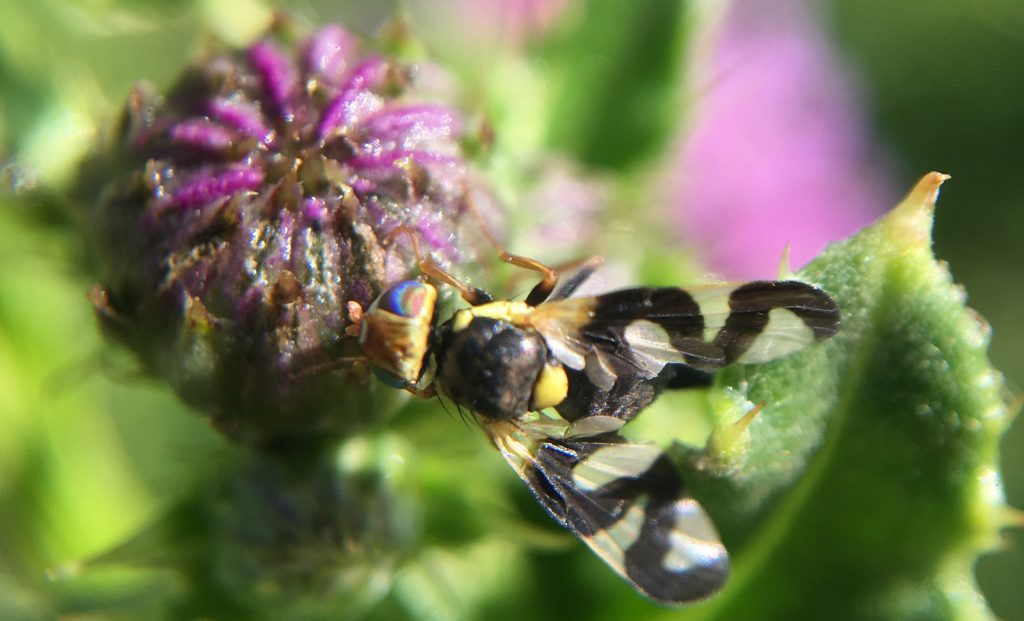Quick links:
Weed Identification | Weed Inspections | Biological Controls (Weevils) | Canada Thistle Stem-Gall Flies | CHAP | Fenceline Program | Ornamental Invasives |
Yellowhead County strives to work as a municipality with our agricultural producers, property owners, or occupants to control or remove Noxious or Prohibited Noxious Weeds on County-controlled public land and private property as stipulated by the Province of Alberta’s Weed Control Act. Yellowhead County’s Agricultural Services Department uses various Weed Management programs, including herbicides, biological controls, and educational awareness campaigns, to reduce noxious and prohibited noxious weeds. Many of the weed control programs are mandated by the province.
Weed Identification
Yellowhead County’s Agricultural Services Department is able to assist residents with weed or plant identification.
Here are some tips to remember that will assist staff in the identification process:
If bringing in a live plant sample for us to identify please:
Try to dig up or pull out the roots along with the rest of the plant. Roots are a very important identifying feature.Put the plant in a cup or pot with some water to keep it from wilting. Some plants wilt very quickly making it harder to see some of the identifying features on the leaves, stems, and flowers.
Try pulling a plant sample that’s the most mature or better yet in the flowering stage.
If you are taking pictures of a plant sample for us to identify please:
- Take at least
4 to 5 pictures of different parts of the plant. Take a picture that
encompasses the entire plant in the frame, then take one of the stem and
leaves, take one of the flower, flower buds, or seed head. Finally, if it’s
possible pull the plant out of the ground and gently knock the soil off to
expose the roots for a picture. - Make sure the
pictures are clear! A lot of the pictures we get are very blurry or the focus
is off the plant and on the grass or trees behind it. To get a clear picture
keep your camera a little further away from the plant, its easier for us to
zoom in on a part of the plant we need more detail on then it is for us to look
at a blurry close up of the plant. - Try to keep
the sun to your back when taking the pictures. If the sun is behind the plant
it can sometimes wash out the colour of the plant or make it blurry and harder
to see fine details. - If you want
to pull the plant and take the pictures indoors with the plant laid out on a
table that works too, just make to take the pictures as soon as you pull the
plant to avoid wilting.
Invasive Species Identification & Notification App & Map https://abinvasives.ca/
A great resource with facts sheets on weeds and other invasive species is the Alberta Invasive Species Council
https://abinvasives.ca/
Invasive Species Fact Sheets
https://abinvasives.ca/category/invasive-species/fact-sheets/
Weed Inspections in the County
Weed inspections take place throughout the summer months in Yellowhead County. Weed Inspectors based in the Wildwood County office will be out in full force documenting various invasive plants on both county and private lands during this time. You may see a white county vehicle near your property and an inspector in a high visibility vest performing weed inspections so please be considerate of their safety.
Please keep in mind that The Weed Control Act grants an Inspector right of entry onto private land during reasonable hours (The Weed Control Act, Part 3, and Section 12). The Agricultural Services Department of Yellowhead County believes that a courtesy should be extended to landowners to inform them of what is taking place on their property. The County continues to promote a “Door Knocking” Program to make contact with landowners before a weed inspection takes place. We inform the property owners of the approximate date and time of when an inspection will take place, and the Weed Inspectors can then address any questions or concerns the landowner may have at that time. If landowners are not home during the time of the “Door Knocking” Program they will find a placard on their door or gate letting them know that an inspector was there and that they can call the inspector for more information before the actual inspection takes place. The results of the inspection(s) and weed information sheets will be mailed out to the landowners within a couple weeks of the completed inspection(s).
If you would like more information regarding the Weed Inspection program, please phone the Agricultural Services Department at the Wildwood County Office at 1 800 814-3935.
For more information about The Weed Control Act, it can be found at the Queens Printer website at www.qp.alberta.ca/
Biological Controls
Canada Thistle Stem Mining Weevil
If you’re looking for an option to control Canada thistle besides using herbicides, handpicking or mowing, this biological control agent may be right for you.
The Canada thistle Stem Mining Weevil (Hadroplontus litura) was introduced from Europe to Canada in 1965 and to the USA in the early 1970’s to feed on Canada thistle. The weevil restricts its feeding to this weed and a few close relatives. Weevil feeding may allow a variety of other micro-organisms to enter the thistle stem, with adverse consequences for the thistle: field studies in Montana indicated that underground parts of stems are much more subject to winter kill if the above ground stem is attacked by weevils during the growing season.
West Central Forage Association has been working with local producers on the release of these weevils for years. Sites, where weevils have been released, have generally shown decreased stand vigour and patches thin out over time. In 2012, 50 dishes (each containing 105 weevils) were brought up from Montana for producers in the West Central Region who were interested in the purchase and release them in thistle patches. Added to this, were 58 dishes for a regional trial set up by the Agricultural Research and Extension Council of Alberta. Yellowhead County also releases these weevils along the edges of rivers, lakes and streams, and in or near right-of-ways where herbicide application is prohibited.
If you are interested in purchasing some Weevils please contact:
West Central Forage Association
1-780-727-4447
conservationag@westcentralforage.com

Weevil Summary Sheet with Before & After Images
Canada Thistle Stem-Gall Flies
The Canada thistle stem-gall fly is a biological control agent for use in controlling Canada thistle. In 2017 WCFA began facilitating the distribution of these agents to producers throughout the province, bringing them in from Montana.
The stem-gall fly attacks the stem of the thistle plant, boring in and causing the plant to form gall tissue. Females lay their eggs on the apical meristem (tip) of developing shoots in the early summer, and larvae burrow into the shoots. Larval feeding triggers gall formation, which stresses the plant. The gall becomes a nutrient sink, directing nutrients away from the plant’s normal metabolic & reproductive functions, lowering normal plant function and reproduction. Abnormally developed flower heads frequently occur above the gall, resulting in fewer flowers and lowered seed production. Galls vary in size, depending on the number of larvae present within. Galls may range in size from small (marble) to large (walnut/plum), containing anywhere from three or four larvae to upwards of 25 larvae. The flies overwinter in the gall as mature larvae and emerge as adults in the spring (around June) as the gall tissue deteriorates.
Stem-gall flies are typically delivered in mid-June each year, with orders needing to be placed ahead of time.

C.H.A.P. (Custom Herbicide Application Program)
Yellowhead County Agricultural Services Board has approved a Custom Herbicide Application Program to control Noxious and/or Prohibited Noxious weeds on private property.
This program will help Yellowhead County residents control weeds where the options of hiring a contractor and renting or purchasing spray equipment are not feasible. The program will be run on a first-come, first-serve basis during the spraying season and as weather permits.
The herbicide will be applied onto the private land, not exceeding 20 acres. Sites will be pre-inspected to determine if the property qualifies for the program and what equipment and herbicide will be necessary.
The landowner will be asked to sign a release allowing the County access to the property and permission to use herbicide as agreed upon by the landowner and Yellowhead County Agricultural Services Staff. Pricing will depend on the area sprayed and the herbicide used. Upon completion, landowners will receive an invoice for the work performed.
Yellowhead County has added CHAP to enhance services to the residents of Yellowhead County in addition to the existing Roadside Vegetation Management Plan and Weed Inspection Program.
If you would like more information on this or any Agricultural Services Programs or to register for CHAP please contact the Agricultural Services Department in Wildwood at 1-800-814-3935.
Fence Line Program
The Fence Line Program helps to control Noxious and/or Prohibited Noxious weeds and encroaching brush along fence lines on private property adjacent to Yellowhead County roads and right-of-ways.
The Fence Line Program will allow Yellowhead County-owned vehicles and equipment to enter the private land and apply herbicide from the fence line to the County Right of Way. This program will help control weeds and brush without the chances of overspray onto private land where sensitive crops or trees may be located.
The herbicide will only be applied to County-owned land and not onto the private land; exceptions are made for fields used for agricultural purposes where landowners may choose to have the four-foot strip from the fence line to their crop sprayed that larger spray equipment or cultivators tend to miss. Sites will be pre-inspected to determine if the property qualifies for the program and what equipment and herbicide will be necessary.
The landowner will be asked to sign a release allowing the County access to the property and permission to use herbicide as agreed upon by the landowner and Yellowhead County Agricultural Services Staff. This program will be completed on a first come first served basis and at no charge to landowners.
Yellowhead County has added the Fence Line Program to enhance services to the residents of Yellowhead County in addition to the existing Roadside Vegetation Management Plan.
If you would like more information on this or any Agricultural Services Programs or to register for the Fence Line Program please contact the Agricultural Services Department in Wildwood at 1 800-814-3935.
Ornamental Invasives
With the ever-growing online ordering world, it is now easier than ever to purchase plants and seeds from outside our province. Often the companies selling these plants or seeds are not located in Alberta or even in Canada, so what is prohibited here may not be the same for where they are located. Local nurseries or wholesale suppliers can also unknowingly ship in plants from out of Province that are regulated under the Weed Control Act of Alberta. This is why it’s so important to always do your research on any new plants you are considering purchasing.
Find out more about Invasive Species to Avoid Planting in Your Garden

